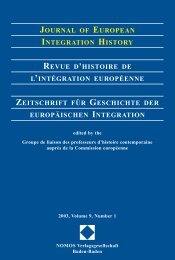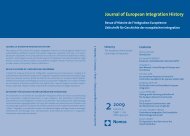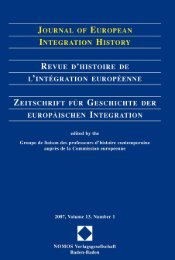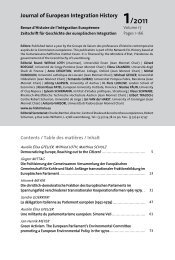journal of european integration history revue d'histoire de l ...
journal of european integration history revue d'histoire de l ...
journal of european integration history revue d'histoire de l ...
Create successful ePaper yourself
Turn your PDF publications into a flip-book with our unique Google optimized e-Paper software.
72<br />
Tapani Paavonen<br />
tra<strong>de</strong>mark <strong>of</strong> Finland. From the 1960s onwards, many chemical industries (SITC<br />
section 5) grew to become significant export industries to the point that Finland has<br />
been a net exporter <strong>of</strong> dyes from the late 1960s. At the same time Finland's import<br />
<strong>de</strong>pen<strong>de</strong>nce on chemical products has <strong>de</strong>creased. 36<br />
The abolition <strong>of</strong> obstacles to tra<strong>de</strong> and economic convergence with regard to<br />
leading industrial countries have created a phenomenon called intra-industry tra<strong>de</strong>,<br />
i.e. import and export tra<strong>de</strong> with similar products. Intra-industry tra<strong>de</strong> is thus one<br />
suitable measure for the proceeding <strong>of</strong> economic <strong>integration</strong>. 37 The Grubel-Lloyd<br />
(GL) indices with regard to the most important trading partners show growing figures<br />
(except for the USSR/Russia) up to the late 1980s/early 1990s, after which the<br />
transformation period for the tra<strong>de</strong> pattern in this respect seems to have en<strong>de</strong>d (see<br />
figure 3). 38<br />
36. For Finland's tra<strong>de</strong> patterns, see T. SUKSELAINEN, Finnish Export Performance in 1961-1972.<br />
A Constant-Market-Shares Approach, Helsinki, 1974, pp.65-70; R. VOLK and H. ESKELINEN,<br />
EEC-vapaakauppa, op.cit., pp.40-51; J.-O. ANDERSSON, Intraindustriell han<strong>de</strong>l och produktcykler<br />
i Finlands utrikeshan<strong>de</strong>l 1965-80, in: Ekonomiska Samfun<strong>de</strong>ts tidskrift, Vol.37, No.3,<br />
Helsingfors (The Economic Society <strong>of</strong> Finland), 1984, p.158; and K. HOFFMAN, Teollisuus, in:<br />
Br. WAHLROOS et al. (ed.), Sotakorvauksista vapaakauppaan. Kauppa- ja Teollisuusministeriön<br />
satavuotisjuhlakirja, Helsinki (The Ministry <strong>of</strong> Tra<strong>de</strong> and Industry), 1988, pp.143-155.<br />
37. According to empirical studies about Finland's intra-industry tra<strong>de</strong>, the following main explanatory<br />
variables have been found: competing tra<strong>de</strong> with natural resources, small role <strong>of</strong> primary production<br />
and incomes level (Aquino indices for 1981), P. PARKKINEN, Ristikkäiskauppa Suomen<br />
ulkomaankaupassa 1981, Helsinki, 1982, pp.18-33; <strong>de</strong>mand diversification measured through income<br />
levels and the share <strong>of</strong> machinery in exports, on one hand, and economic <strong>integration</strong> measured<br />
through dummies original EFTA country, original EEC country, Nordic country, on the other<br />
(GL indices for Denmark, Finland, Norway and Swe<strong>de</strong>n for 1965, 1973 and 1980), J.-O. AN-<br />
DERSSON and Y. TOLONEN, Intra-Industry Tra<strong>de</strong> in the Nordic Countries, in: EFTA Occasional<br />
Paper 12/1985, Geneva, 1985, pp. 6-17; small per capita income differential, high average per<br />
capita income, large average market size, small market size inequality, high R & D expenditure,<br />
sufficiently low concentration ratio, not too big average plant size, low transport costs and large<br />
direct investments (GL indices for 1985), M.-L. PARJANNE, Econometric Analyses <strong>of</strong> Intra-Industry<br />
Tra<strong>de</strong>. Evi<strong>de</strong>nce from Finnish Cross-Sectional Data, Helsinki School <strong>of</strong> Economics and<br />
Business Administration, Helsinki, 1992, pp.33-47, 113-118, 129-140, 147-186 & 192-196.<br />
38. The Grubel-Lloyd in<strong>de</strong>x measures the <strong>de</strong>gree or share <strong>of</strong> intra-industry tra<strong>de</strong> in foreign tra<strong>de</strong>; the closer<br />
to 0 the less the tra<strong>de</strong> is <strong>of</strong> an intra-industrial nature and the closer to 1 the more the tra<strong>de</strong> is <strong>of</strong> an<br />
intra-industrial nature (0 ≤ GL ≤ 1). It is calculated with the formula: GL = 1 – [∑ Abs (m – x) / ∑<br />
(m + x)], where m and x are the import and export values <strong>of</strong> each <strong>of</strong> the commodity groups. Economists<br />
usually presume that the products concerned are genuine substitutes to each other. The present<br />
study, however, contents itself with that the products concerned represent similar factor endowments,<br />
which is assumed to be the case, as the rule, within 2-digit classes <strong>of</strong> SITC, which combine in a suitable<br />
way, by and large, similar processing rates within the same industry. Figure 3 gives the GL indices on<br />
2-digit level <strong>of</strong> SITC for divisions 51-89, i.e. industrial goods. The relative position <strong>of</strong> different trading<br />
partners to each other, however, is essentially the same when the indices are calculated for all divisions<br />
<strong>of</strong> SITC or at a different level <strong>of</strong> aggregation.

















